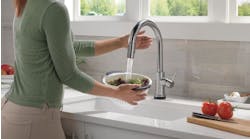MILWAUKEE — Any contractor who has not heard John Siegenthaler speak should jump at the opportunity because he always has something new and interesting to say. That was the case at the Solar Thermal ’12 conference and show here in early December, where Siegenthaler spoke in two sessions on how hydronic heating distribution systems tie in with alternative energy sources.
At Solar Thermal ’12, Siegenthaler built on his 2011 presentation on how hydronic systems are the enabler for alternative energy sources and talked about products that are not commercially available that he’d like to see.
Solar Thermal ’12, like its 2011 predecessor (solarthermalconference.org), is sponsored by the Midwest Renewable Energy Association. CONTRACTOR magazine’s quarterly supplement, Green Mechanical Contractor magazine, is one of the media sponsors of the event.
“Modern hydronics is the enabling technology, the glue that ties together all thermal renewable systems,” Siegenthaler said, whether the heat source is solar, a heat pump, a wood boiler or heat recovery.
Low temperature distribution systems are the key to any type of heating system that gets its heat from an alternative energy source, and water is the best way to distribute that heat. Because the specific heat of water is so much higher than that of air, he explained, water holds 3,500 times more energy than a comparable volume of air.
He explained the significance of low-wattage ECM circulators and how they will become, by law, the standard in Europe. A well-designed, highly efficient, low temperature hydronic distribution system can deliver a lot of Btus at 10% of the wattage of a forced air system. Such a system that includes thermal storage is easy to integrate with conventional heat sources.
Siegenthaler enumerated some guiding principles. The building must be insulated so that it has a low heat loss of 10-15 Btuh/sq.ft. The system must use low temperature distribution. Well-insulated buildings are subject to internal heat gains, so the system must be zoned room by room. Don’t use efficient heat sources, such as condensing boilers, with inefficient distribution. Keep the system simple — no wall full of circulators. Design the system so that water temperature never exceeds 120°F.
Well-insulated buildings and low-temperature distribution can make heated floors the wrong choice, he explained. The formula for the floor temperature includes the Btuh/sq.ft. heat loss and the thermostat setting: Tf= q/2 + Tr. If q, the heat loss, is only 10 Btuh/sq.ft. in a well-insulated house, and the thermostat setting is 68°F, then Tf = 10/2 + 68, or 73°F. A 73°F floor, to most people, is not the toasty warm floor expected of radiant floor heat. Consequently, radiant ceilings, radiant walls, or some of the European-style low-water content, fast response panel radiators would be a better option than the floor.
Siegenthaler had borrowed a FLIR thermal imaging camera and he showed the contractors pictures of panel radiators and radiantly heated ceilings, walls and floors.
Siegenthaler would like to see two related products come to market. Thermal storage is a must with any alternative energy system and you can’t find pressurized tanks with internal coils in the North American market larger than 119-gal. Siegenthaler would like to see pressurized tanks from 150-500-gal. with internal helical copper or stainless steel coils and a variety of input and output ports. Large tanks allow stratification and an engineer like Siegenthaler can design a system using that stratification to move water at different temperatures to different loads.
The second thing that Siegenthaler would like to see is an instant domestic hot water heating appliance on the outside of the tank. The external device would be comprised of a small circulator, a stainless steel plate and frame heat exchanger, an ASSE 1017 anti-scald valve, and an electric tankless backup heater. A thermostatically controlled, solid-state electric tankless heater could boost water temperatures from 1°F to whatever is desired. A gas tankless heater, on the other hand, wants to see a 20°F ∆T before it fires. The heat exchanger, typically 5-in. x 12-in., should be sized for a 10°F approach temperature and will respond in about five seconds. The low wattage circulator would cost about $1 a year to run. And since the whole package is outside of the storage tank, it’s easily serviced.
It’s easy to tie solar thermal in with a hydronic system, Siegenthaler told the solar contractors, using a conventional heat source, such as a boiler, as backup. Don’t design solar monuments, he cautioned. There will be so much excess capacity in the summer that most designs should be sized for 100% of the domestic hot water load and space heat “buffering” in the spring and fall. Such a system would have no more than four to eight collectors.
A contractor can design a drain-back system using either pressurized or open tanks, he said. With open tanks, it’s possible to both inject and draw out hot water using a four-way valve. He cautioned the attendees that open tank systems require the circulators to be all stainless steel or bronze.

